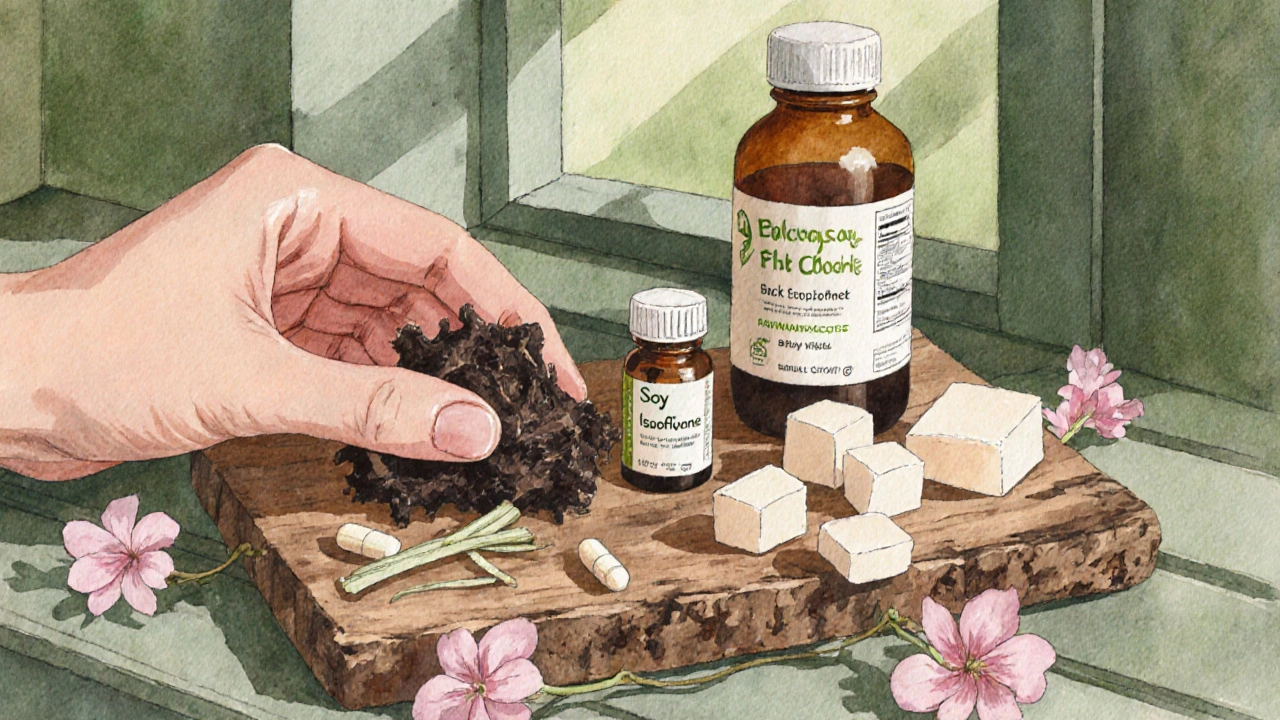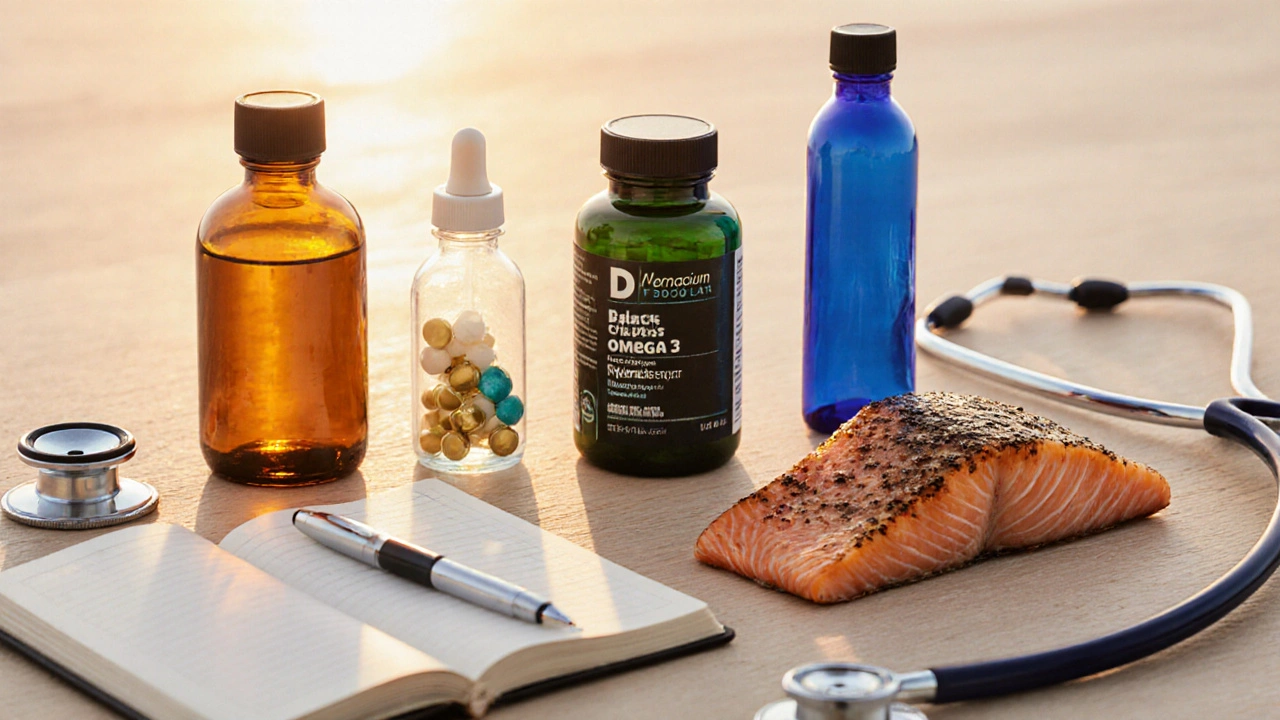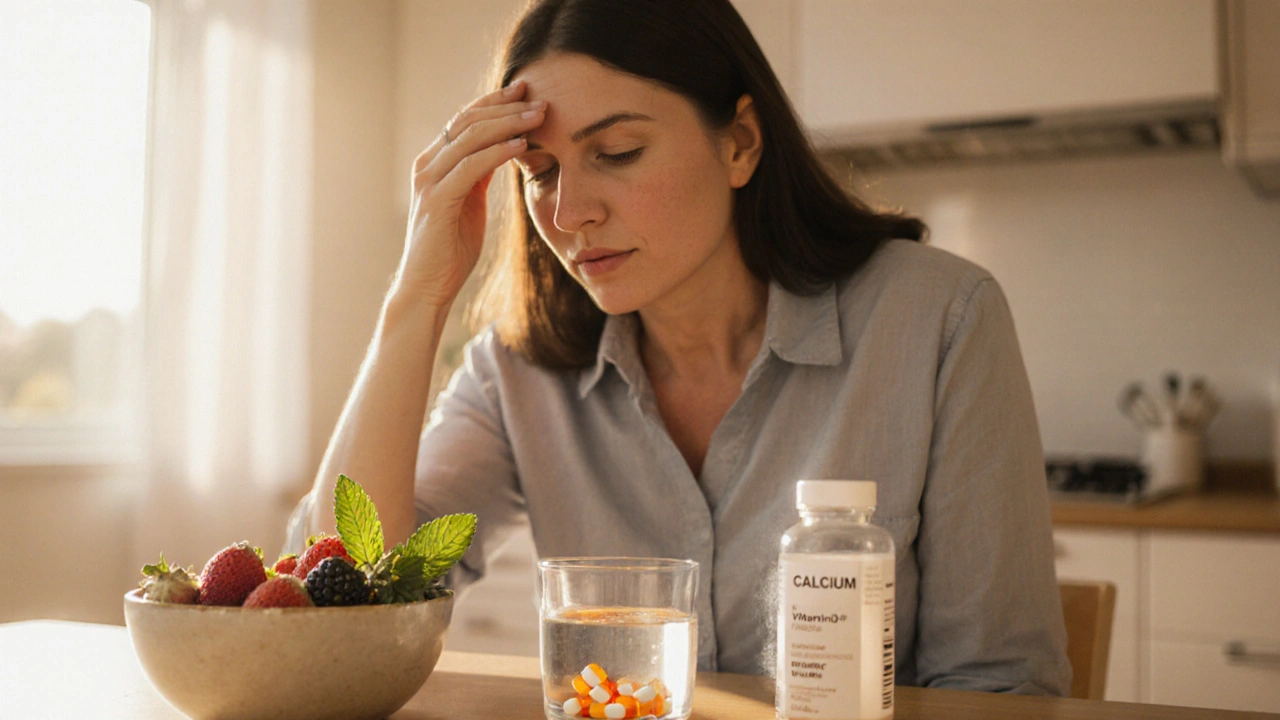Menopause Supplement Calculator
Personalized Supplement Recommendations
This tool helps determine appropriate dosages for menopause-related supplements based on your individual factors. Always consult with a healthcare provider before starting any new supplement regimen.
Your Supplement Recommendations
Essential Supplements
Additional Recommendations
Key Takeaways
- Vitamin D, calcium, magnesium, and vitamin E have the strongest research backing for hot‑flashes, bone health, and mood support.
- Herbal options like black cohosh and soy isoflavones can help with night sweats, but dosage consistency matters.
- Omega‑3 fatty acids improve cardiovascular health and may reduce joint pain during menopause.
- Combine supplements with whole‑food nutrition and regular movement for the best symptom control.
- Always check for interactions with any prescription meds and discuss plans with a healthcare professional.
When women enter Menopause is the natural phase marking the end of menstrual cycles, typically occurring between ages 45‑55. During this transition, hormone shifts trigger hot flashes, night sweats, sleep disturbances, mood swings, and a gradual loss of bone density. While hormone replacement therapy (HRT) works for many, a growing number of women look to menopause supplements as a gentler, more personalized way to manage symptoms.
Why Vitamins Matter for Menopause
Vitamins are the building blocks of the body’s biochemical reactions. When hormone levels dip, certain nutrients become critical allies.
Vitamin D helps the body absorb calcium, supporting bone strength-a key concern as estrogen‑driven bone loss accelerates. Studies from 2023 show that women with serum vitamin D levels above 30ng/mL report 30% fewer hot flashes.
Calcium works hand‑in‑hand with vitamin D. The Australian Dietary Guidelines recommend 1,300mg daily for women over 50. Consistent intake can cut osteoporosis risk by up to 40%.
Vitamin E is a potent antioxidant. A 2022 double‑blind trial found that 400IU of natural vitamin E reduced the frequency of moderate‑to‑severe hot flashes by 25% after eight weeks.
Magnesium relaxes smooth muscle and supports sleep. Women supplementing 300‑400mg nightly reported better sleep quality and fewer night‑time sweats.

Herbal and Phytoestrogen Options
When you can’t or don’t want to use synthetic hormones, plant‑based compounds that mimic estrogen become attractive.
Black cohosh (Actaea racemosa) has been used traditionally for hot flashes. A meta‑analysis of 15 trials in 2024 gave it a moderate evidence rating: about 40% of users experienced a noticeable reduction in heat intensity.
Soy isoflavones are phytoestrogens found in tofu, tempeh, and supplements. Daily doses of 80-100mg have shown a 20‑30% drop in night‑sweat episodes, especially when combined with a balanced diet low in saturated fat.
Omega‑3 Fatty Acids: Heart and Joint Support
Cardiovascular risk climbs after menopause. Omega‑3 fatty acids, particularly EPA and DHA, lower triglycerides and may ease joint stiffness. A 2021 Australian cohort study linked a weekly intake of two servings of oily fish (or 1g EPA/DHA supplement) with a 15% reduction in reported joint pain.
Choosing the Right Supplement Regimen
With so many options, a simple checklist helps keep you on track:
- Get a baseline blood test for vitamin D, calcium, and magnesium levels.
- Start with one new supplement at a time; give it four weeks before adding another.
- Match doses to reputable guidelines (e.g., 1,000IU vitamin D, 1,200mg calcium, 400IU vitamin E, 300mg magnesium, 40mg black cohosh extract).
- Track symptoms in a journal - rate hot flashes, sleep quality, and mood on a 1‑10 scale.
- Review results with your GP or a qualified naturopath every three months.

Potential Pitfalls and Safety Tips
Even “natural” isn’t risk‑free. Here are the most common issues:
- Over‑supplementation: Too much calcium can raise kidney stone risk; keep total intake (diet + supplement) under 1,300mg.
- Interactions: Black cohosh may amplify the effects of blood‑thinning medications. Vitamin E at high doses also has a mild anticoagulant effect.
- Quality variance: Choose third‑party tested brands; look for USP or TGA certification.
Sample Daily Supplement Plan (Illustrative Only)
Below is a practical example for a 52‑year‑old woman without chronic kidney disease or blood‑clotting disorders. Adjustments are essential based on individual labs and health history.
| Supplement | Primary Benefit | Typical Dose | Evidence Rating (2024) |
|---|---|---|---|
| Vitamin D | Bone health, hot‑flash reduction | 1,000IU daily | High |
| Calcium | Bone density maintenance | 1,200mg split into two doses | High |
| Vitamin E | Hot‑flash frequency | 400IU daily | Moderate |
| Black Cohosh Extract | Heat intensity relief | 40mg standardized | Moderate |
| Omega‑3 (EPA/DHA) | Heart health, joint comfort | 1g daily | High |
Frequently Asked Questions
Can I replace HRT entirely with supplements?
Supplements can ease many symptoms, but they don’t fully replicate estrogen’s wide‑range effects. Women with severe vasomotor symptoms often benefit from a combined approach-low‑dose HRT plus targeted nutrients.
How long does it take to notice improvements?
Most nutrients need 4‑6 weeks of consistent use before measurable changes appear. Herbal extracts like black cohosh may show effects within two weeks, but individual response varies.
Should I take all these supplements together?
Start with calcium+vitaminD, then add vitaminE or magnesium after a month. Introduce one herbal product at a time to monitor tolerance. Always space doses with food to improve absorption.
Are there any foods that boost the effectiveness of these supplements?
Fat‑rich foods (olive oil, avocado, nuts) increase absorption of vitaminD and omega‑3s. Pair magnesium with leafy greens or whole grains. Avoid excessive caffeine, which can worsen calcium loss.
Is it safe to take supplements if I have high blood pressure?
Generally yes, but watch the sodium content in some calcium carbonate tablets and discuss any herbal extracts with your doctor, as black cohosh may affect blood pressure in rare cases.


Comments
Tyler Heafner
The article provides a comprehensive overview of the role vitamins and supplements can play in easing menopause symptoms, citing recent studies and offering practical dosage suggestions.
October 14, 2025 AT 15:53
Maryanne robinson
Thank you for sharing this thorough guide; as someone who has navigated menopause with a combination of nutrition and supplementation, I can attest to the value of a structured approach. First, establishing a baseline with a vitamin D and calcium panel is essential because deficiencies can exacerbate bone loss and hot flashes. Second, many women underestimate the impact of magnesium on sleep quality, and a nightly dose of 300‑400 mg can make a noticeable difference in night sweats. Third, the inclusion of vitamin E at 400 IU daily is supported by several double‑blind trials, yet it should be introduced gradually to monitor tolerance. Fourth, black cohosh can be beneficial for heat intensity, but it must be used with caution in those on blood thinners, as the article correctly points out. Fifth, omega‑3 fatty acids not only support cardiovascular health but also help reduce joint discomfort that can accompany hormonal shifts. Sixth, I recommend pairing calcium supplements with meals that contain some dietary fat to improve absorption. Seventh, consistency is key: keep a symptom journal and rate each symptom on a 1‑10 scale to track progress objectively. Eighth, avoid excessive caffeine and alcohol, which can trigger vasomotor symptoms. Ninth, stay hydrated; adequate water intake supports overall metabolic function. Tenth, consider adding a high‑quality multivitamin that covers B‑complex vitamins, which play a role in mood regulation. Eleventh, always discuss any new supplement regimen with your healthcare provider, especially if you are on prescription medications. Twelfth, be aware of the upper limits for certain nutrients to prevent adverse effects, such as kidney stones from excess calcium. Thirteenth, choose third‑party tested brands to ensure purity and potency. Fourteenth, remember that supplements complement, not replace, a balanced diet rich in fruits, vegetables, and whole grains. Fifteenth, regular weight‑bearing exercise synergizes with calcium and vitamin D to strengthen bone density. Sixteenth, give each new supplement at least four weeks before adding another to assess its individual impact. In summary, a personalized, stepwise supplement plan, combined with lifestyle modifications, can significantly improve quality of life during menopause.
October 14, 2025 AT 17:33
Vintage Ireland
Honestly, reading this felt like a breath of fresh air-it's rare to see such a balanced mix of science and practical advice. I’ve been juggling hot flashes and mood swings for a couple of years, and the vitamin D and magnesium suggestions have already helped me sleep better. The way the article warns about interactions with blood thinners is a lifesaver; I’m on a low‑dose aspirin, so I appreciate that heads‑up. I also love the tip about taking omega‑3 with fatty foods for better absorption-my fish oil finally feels worth the money.
October 14, 2025 AT 19:13
Gene Nilsson
It is unfortunatly thoughtless to propose supplement regimens without emphasing the moral obligation to consult a physician first, especially when dealing with vulnerable demographics. The article, while informative, fails to stress the ethical gravity of self‑medicating in the face of complex hormonal changes.
October 14, 2025 AT 20:53
Anshul Gupta
The so‑called "evidence" behind black cohosh is flimsy at best; many studies are underpowered and biased. Anyone reading this should be skeptical of herbal hype.
October 14, 2025 AT 22:33
Erika Ponce
i think u should double check the sources lol but the tip about calcium is good i guess
October 15, 2025 AT 00:13
Danny de Zayas
Looks solid, good rundown of the basics.
October 15, 2025 AT 01:53
John Vallee
Wow, this really hits home! I’ve always believed that education is the first line of defense against uncomfortable symptoms, and this article proves that point brilliantly. The step‑by‑step checklist is nothing short of a lifeline for anyone feeling lost in the sea of conflicting advice. I especially love the recommendation to start with one supplement at a time; it’s a pragmatic approach that respects the body’s ability to adapt. The emphasis on tracking symptoms in a journal resonates deeply-data is power, after all. Moreover, the caution about calcium excess and kidney stones demonstrates a nuanced understanding of nutrient interactions. The cultural references to different dietary patterns also add a layer of inclusivity that is often missing in health articles. Finally, the call to discuss any changes with a healthcare professional underscores the article’s commitment to safety. Overall, this piece is a masterclass in marrying scientific rigor with real‑world applicability.
October 15, 2025 AT 03:33
Brian Davis
Building upon the dramatic insights shared earlier, it’s worth noting that cultural dietary habits influence how we metabolize these nutrients. For instance, traditional Mediterranean meals naturally provide omega‑3s and vitamin D through fish and fortified dairy, reducing the need for high‑dose supplements. Conversely, diets low in fat may impair the absorption of fat‑soluble vitamins, necessitating mindful pairing with healthy oils. Such nuances highlight why a one‑size‑fits‑all recommendation falls short, reinforcing the article’s call for individualized plans.
October 15, 2025 AT 05:13
jenni williams
Great stuff! 😊
October 15, 2025 AT 06:53
Kevin Galligan
Oh sure, because popping a handful of pills magically erases hot flashes-real genius. 🙄
October 15, 2025 AT 08:33
Dileep Jha
From a systems‑theoretic perspective, the supplementation matrix operates as a feedback loop within the endocrine network, modulating homeostatic set‑points via nutrient‑receptor crosstalk. Hence, blanket recommendations lack the granularity required for optimal therapeutic modulation.
October 15, 2025 AT 10:13
Shivali Dixit Saxena
Well, I disagree; the article oversimplifies the bioavailability issues-especially for calcium carbonate versus citrate!; plus, the timing of intake relative to meals is critical.
October 15, 2025 AT 11:53
Sayam Masood
There is a subtle wisdom in recognizing that every supplement is a dialogue between the body’s present state and its future aspirations; we must listen as much as we dose.
October 15, 2025 AT 13:33
Jason Montgomery
Thanks for that insight-keeping the conversation open helps all of us make better choices.
October 15, 2025 AT 15:13